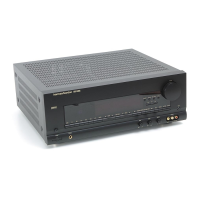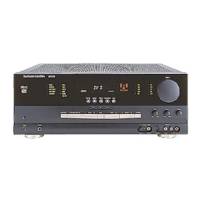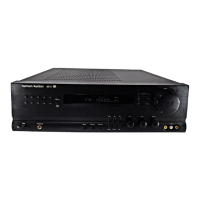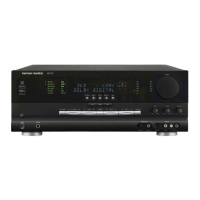Installation and Configuration
IMPORTANT NOTE:Many listeners are
often confused about theoperation of the
rear (surround) channels. Whilesome
assume that soundshould always be com-
ing from eachspeaker, most of thetime
there will belittle or no soundin the sur-
round channels. Thisis because they are
only used whena movie director orsound
mixer specifically placessound there to cre-
ate ambiance, an effector to continue
action from the front of the room to the
rear. When the output levelsare properly set
it is normalfor rear/surround speakers to
operate only occasionally. Artificially
increasing the volumeto the rear speakers
may destroy theillusion of an enveloping
sound field thatduplicates the way youhear
sound in amovie theater or concerthall.
It is also important to note that the Dolby
Pro Logic surround processing used in the
rear channel is a single monaural feed,
even though there are two speakers. The
position of the speakers and the relation-
ship of the level of sound in the rear chan-
nel and the front left or right channels
creates the effect of directional sounds for
the rear channels. Thus, when adjusting
the rear channel there is only one, as
opposed to two adjustments.
To begin the adjustment process make cer-
tain that all speaker connections have been
made. Then set the system volume to the
level that you will use during a typical lis-
tening session. Next, press the Calibrate
button
(q
on the front panel or remote.
Note that the front panel display will chan-
ge to read LF(Left Front) although there
will be no change to the system output.
NOTE: The Balance control
$
should
be at the midpoint, or “12 O’clock” posi-
tion when calibrating the system.
Press the Calibrate button
q
on the
remote
again and note that a test tone
will be heard from the left front speaker.
Press the Speaker
›
button
s
on the
remote and observe that the test noise will
move first to the centre speaker, then to the
front right speaker and then to the rear
speakers as you press the button. This is a
good opportunity to check for proper
speaker connections by listening to the test
noise and checking to see that it is coming
from the speaker location indicated in the
front panel display.
While seated at your preferred listening
position, press the Speaker
‹
or
›
but-
tons
s
on the remote to return the test
tone to the front left speaker and make
any fine tuning to the volume setting
using the Volume control
l
. Next,
press the Speaker
›
button
s
to move
the test noise to the centre channel. Use
the Level + or Level - buttons
t
so
that the sound level appears identical to
the left front channel.
Press the Speaker
›
button
s
again to
listen to the front right channel for refer-
ence purposes, and then press the
Speaker
›
button
s
so that the test
noise moves to the rear channel. Use the
Level + or Level - buttons
t
to adjust
the volume level so that it appears identi-
cal to the other channels.
After making initial adjustments to the
system it is a good idea to repeat the pro-
cedure again, switching the channels
more quickly in order to hear and adjust
for any differences between the channels.
When the procedure is concluded the
volume level from all channels should
be as equal as possible.
To end the adjustment reduce the Volume
control
Ùl
until the test noise is quite
low and press any Calibrate button
(
q
, or any input source selection button on
the remote or front panel.
NOTE: It is also possible to adjust the
channel levels while listening to any input
source by pressing any Calibrate button
( q
only once and adjusting the levels
using the main Volume control
Ùl
and the Level + - buttons t to change
the levels and the SPKRS
‹ ›
buttons
s
to change the channel being adjusted.
During this procedure, however, all chan-
nels will be heard simultaneously.
Delay Setting
Delay time adjustment enables you to
adjust the timing between signals at the
front and surround channels.
The factory setting of 20 milliseconds is
appropriate for most rooms, but an abun-
dance of hard (reflective) surfaces such as
windows and wood floors, or soft
(absorbent) surfaces such as thick carpet-
ing, acoustical tiles and some furnishings
may create an unpleasant effect. These
surfaces, in conjunction with the size of
the room, the height of the ceiling and
other design aspects may cause the arrival
of surround channel sounds to become
disconnected from front channel sounds.
To adjust the delay time press the Delay
button
*
on the front panel several times
until the time shown in the Information
Display
¯
is as close as possible to the
result of the following formula.
1. Measure the distance from the listening
position to the front speakers in meters.
2. Measure the distance from the listening
position to the surround speakers in meters.
3. Subtract the distance to the rear speakers
from the distance to the front speakers, add
5 and multiply the result by 3. That num-
ber is the ideal delay time in milliseconds
for your room. For example, if the front
speakers are 3 meters away and the rear
speakers are 1 meter away, the formula will
be “((3-1)+5)x3=21.” Thus, the correct
delay time in this room would be set at 20
milliseconds.
14
ENGLISH
32642_AVR41 Eng 04/03/1998 9:03 Side 14

